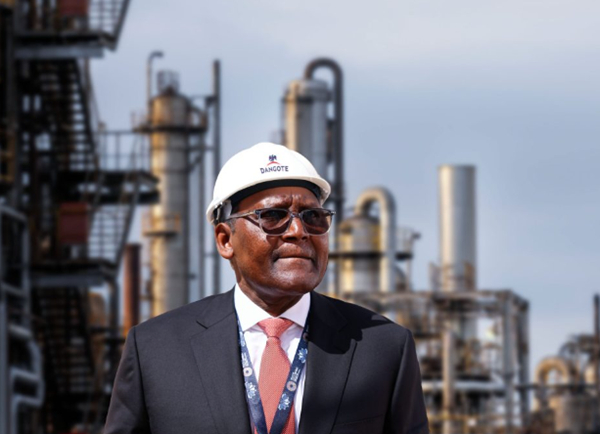Dangote refinery supplies 60% of Nigeria’s petrol —Report

A new report by S&P Global has stated that the Dangote Petrochemical Refinery is now fulfilling up to 60 percent of the nation’s domestic gasoline (petrol) demand.
It said the development highlights the refinery’s growing role in stabilising the country’s fuel supply and reducing dependence on imports, making a substantial impact on the local energy market.
However, this contradicts a recent revelation by the Nigerian Midstream and Downstream Petroleum Regulatory Authority, which has disclosed that the country’s three operational refineries contribute less than 50 per cent of the nation’s daily petrol consumption.
Since starting up in January 2024, gasoline output from the giant 650,000 b/d refinery has remained a closely watched topic, promising to drastically overhaul Nigeria’s import deficit by serving the bulk of the country’s main fuel market.
Beating most analyst forecasts, the refinery began operating its key gasoline unit, the residue fluid catalytic converter, in September, and officials have promised it could reach its full capacity by mid-March.
Speaking to Platts in late January, a Dangote Group executive said that the refinery was producing over 30 million litres/day of gasoline, reporting that the site had surpassed 85 per cent utilisation.
Equating to roughly 200,000 b/d, that output would cover the bulk of roughly 350,000 b/d gasoline demand in Nigeria estimated by S&P Global Commodity Insights analysts.
Initially, market sources have remained sceptical over actual production volumes, pointing to opaque output from Dangote and two newly restarted state-owned refineries, Port Harcourt and Warri.
But growing output appeared to dramatically displace the country’s gasoline imports in January when volumes dropped to an all-time low.
According to S&P Global Commodities at Sea data, Nigeria imported 62,000 b/d of gasoline in the first month of 2025, down from a 2024 average of around 200,000 b/d.
“They are importing a lot less, and traders are making up the shortfall from offshore Lome,” said one trader, referring to the nearby transhipment hub off the coast of Togo where traders blend products.
He called the 85 per cent utilisation estimate “very doubtful,” however. Others noted that vessel tracking may not identify volumes imported on smaller vessels from offshore Lome.
Though exact import volumes are hard to determine, sources now agree that the Dangote refinery is almost solely responsible for the downward trajectory in imports.
By late February, state-owned refineries appear to be making little to no contribution to local gasoline balances.
On Feb. 8, Nigeria’s national oil company, NNPC, reported that Warri was undergoing maintenance, while Port Harcourt is also offline, according to trade sources.
NNPC has denied any outage at the Port Harcourt site, asserting that it is “fully operational and consistently receiving crude oil.”
However, four crude oil traders reported that the site was reoffering its Escravos crude allocations in February.
Discussing Dangote’s contribution to falling imports, Ikemesit Effiong, partner at Lagos-based SBM Intelligence, said the new refinery was primarily responsible.
“They’re supplying the market at frankly (pleasantly) surprising volumes,” he said, noting that three major retailers had switched to sourcing products from the plant. “A lot of NNPC retail outlets are not provisioned and are not selling at the moment, while Dangote-supplied stations are doing just fine.”
European exporters are increasingly feeling the effects of a weaker pull from the Nigerian market but could still see fluctuations in the event of outages.
In January, a brief outage at the refinery’s RFCC unit triggered a spike in gasoline fixtures from the Northwest European market, while February import volumes have already started to increase.
Even after its operations stabilise, the scale and complexity of the Dangote refinery come with a high outage risk, leaving import markets as an important backstop, analysts have warned.
Rasool Barouni, head of refining at Commodity Insights, said the refinery is still exposed to disruptions, particularly within the first years of its ramp-up while operations are less stable.
“Operating a large Residue Fluid Catalytic Cracking unit presents significant challenges,” he said, noting high operating and logistics costs associated with its design.
“Dangote’s RFCC requires a substantial amount of fresh FCC catalysts and additives while also producing a considerable volume of spent catalyst,” he added.
Similarly, logistical constraints could also pose potential bottlenecks for the site in the future, traders have said, as the refinery has kept markets guessing over how it is managing its local distribution.
The refinery supplies the domestic market using a mixture of trucks and intra-Nigerian cargo deliveries, though traders say it has limited capacity to boost its road freight.
“They are doing about 15,000 mt by truck, while vessels are 20,000-70,000 mt clips reimported,” the trader estimated.
The second source approximated that the refinery’s single-point mooring system was loading around 60,000 mt of gasoline per month.
Limited oversight has left market watchers focused on import data, however, as the refinery appears finally on the cusp of dominating the domestic market.
There are still volumes coming from Europe, of course, but something like 50 to 80 per cent of the exports are gone,” said one Northwest European trader.
Source: www.punchng.com





